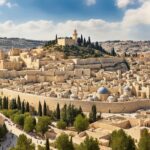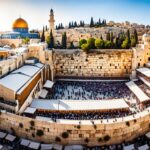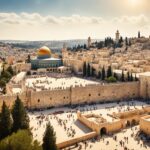The Temple Mount, also known as Haram al-Sharif and Al-Aqsa Mosque compound, is a sacred site in Jerusalem that holds deep religious significance in Judaism, Christianity, and Islam. It has a rich history dating back thousands of years and is considered the holiest site in Jerusalem.
The Temple Mount’s history is intertwined with the religious traditions of multiple faiths. It is believed to be the location where the First and Second Jewish Temples once stood. These temples were central to Jewish worship and served as important cultural and political centers. The Temple Mount also has associations with significant events in Christianity, such as Jesus’ teachings and actions within the temple complex. For Muslims, it is home to the Al-Aqsa Mosque, which is one of the three holiest sites in Islam.
Key Takeaways:
- The Temple Mount is a holy site in Jerusalem that is significant in Judaism, Christianity, and Islam.
- It has a rich history dating back thousands of years.
- The First and Second Jewish Temples were once located on the Temple Mount.
- The Al-Aqsa Mosque is an important religious symbol for Muslims.
- The Temple Mount holds great cultural and spiritual significance for people of various faiths.
The History of the Temple Mount
The Temple Mount has a long and storied history, deeply intertwined with the religious beliefs and cultural heritage of Jerusalem. It is believed to be the sacred location where the First and Second Jewish Temples once stood, making it an important site for the Jewish people.
The construction of the First Temple, known as Solomon’s Temple, began in 957 BCE and was completed in 947 BCE. This magnificent structure served as the center of worship and religious activity for the ancient Israelites. However, it was destroyed by the Neo-Babylonian Empire in 587 BCE, marking a significant event in Jewish history.
After the exile, the Second Temple was built on the same site. It was constructed starting in 516 BCE and was a symbol of hope and restoration for the Jewish people. However, the Second Temple also faced a tragic fate. It was destroyed by the Roman Empire in 70 CE during the Great Jewish Revolt, leaving only the Western Wall as a remnant of this once-majestic structure.
Despite the destruction of the temples, the Jewish people continue to hold the Temple Mount in high regard due to its historical and religious significance. It remains a powerful symbol of their connection to their ancestral homeland and their long-standing ties to Jerusalem.
Throughout its history, the Temple Mount has witnessed the rise and fall of empires, religious conflicts, and the struggles of different cultures. Today, it stands as a testament to the enduring spirit of faith and the diverse tapestry of human history.
The Religious Significance of the Temple Mount
The Temple Mount holds immense religious significance for three major Abrahamic religions – Judaism, Christianity, and Islam. It is revered as one of the holiest sites in Jerusalem and is central to various religious traditions practiced by millions of people around the world.
For Jews, the Temple Mount is of paramount importance, representing a connection to their ancient history and spiritual heritage. It is believed to be the location where the First and Second Jewish Temples once stood. The Western Wall, a remnant of the Second Temple, is particularly revered by Jews and serves as a site for prayer and pilgrimage. Jews also associate the Temple Mount with profound biblical events, embodying their faith and cultural identity.
“For Jews, the Temple Mount is not simply a historical or architectural relic. It is a living symbol of their faith, representing a spiritual link to their ancestors and a tangible expression of their connection to God.”
Christians also recognize the religious significance of the Temple Mount. It is closely associated with important events in the life of Jesus Christ, such as his overturning of the tables of the money changers. Additionally, the Temple Mount is considered a sacred place where Jesus taught and prayed, making it an important pilgrimage site for Christians from around the world.
For Muslims, the Temple Mount holds deep religious meaning. It is home to two prominent Islamic structures – the Al-Aqsa Mosque and the Dome of the Rock. The Al-Aqsa Mosque is the third holiest site in Islam and is believed to be the place where the Prophet Muhammad ascended to heaven during his Night Journey. The Dome of the Rock, with its iconic golden dome, holds immense symbolism and is revered as a cornerstone of Islamic architecture.
“The Temple Mount is a sacred space for Muslims, a place of profound spiritual significance that reflects the beauty and grandeur of Islamic art and architecture.”
These religious traditions and beliefs associated with the Temple Mount underscore its enduring importance and continue to shape the spiritual and cultural landscape of Jerusalem.
Religious Significance of the Temple Mount
| Religion | Significance |
|---|---|
| Judaism | One of the holiest sites, connection to ancient history, site of prayer and pilgrimage |
| Christianity | Associated with important events in the life of Jesus Christ, pilgrimage site |
| Islam | Home to Al-Aqsa Mosque and Dome of the Rock, third holiest site, symbolic and architectural significance |
The Structures on the Temple Mount
The Temple Mount is home to two significant structures – the Dome of the Rock and the Al-Aqsa Mosque. The Dome of the Rock is a striking gold-domed shrine that sits atop the Temple Mount. It is considered one of the oldest existing Islamic structures in the world and holds great significance for Muslims. The Al-Aqsa Mosque, located adjacent to the Dome of the Rock, is the second oldest mosque in Islam.

Together, these structures make the Temple Mount a visually impressive and spiritually significant site.
Access to the Temple Mount
Visiting the Temple Mount is a unique and meaningful experience for travelers. To ensure a safe and respectful visit, it’s important to understand the rules and regulations set by the Temple Mount’s authority, the Jerusalem Islamic Waqf.
There are a total of eleven gates that provide access to the Temple Mount, each with its own purpose and significance. Ten of these gates are reserved for Muslims, while one gate is designated for non-Muslims.
When entering the Temple Mount as a non-Muslim visitor, it’s important to be aware that access is typically restricted and limited. The primary purpose of visiting the Temple Mount for non-Muslims is to experience its historical and architectural beauty, rather than for religious practices or prayer.
It is crucial to respect the religious customs and regulations observed on the Temple Mount. Non-Muslim visitors are prohibited from engaging in any form of prayer while on the site. This rule helps maintain a peaceful and inclusive atmosphere for all visitors, regardless of their religious beliefs.
By adhering to these guidelines, visitors can contribute to a positive and harmonious environment while exploring the remarkable historical and spiritual significance of the Temple Mount.
Access Points to the Temple Mount:
| Gate Name | Accessibility | Description |
|---|---|---|
| Sultan Suleiman Mosque Gate | Non-Muslims | This gate provides access for non-Muslim visitors, and it is important to note that the opening hours are subject to change. |
| Al-Mughrabi Gate | Muslims | The main entrance for Muslim visitors, it is known for its distinctive ramp access. |
| Cotton Merchants’ Gate | Muslims | An entrance mostly used by Muslim worshippers coming from the Old City markets. |
| Mughrabi Bridge Gate | Muslims | This gate is used by Muslim worshippers and visitors coming from the Western Wall Plaza. |
| Chain Gate | Muslims | An entrance often used by Muslim worshippers residing in the Muslim Quarter. |
| Moroccan Gate | Muslims | Used by Muslim worshippers, this gate leads to the underground mosque. |
| Lions’ Gate | Muslims | An entrance primarily used by Muslim worshippers and locals living in the nearby neighborhoods. |
| Golden Gate | Muslims | A significant gate with historical and religious value, it is currently closed. |
| Mughrabi Road Gate | Muslims | Facilitates access for Muslim worshippers, especially those arriving from the East Jerusalem neighborhoods. |
| Women’s Gate | Muslims | This gate is exclusively used by Muslim women to access the Temple Mount. |
| Iron Gate | Muslims | This gate is currently closed to visitors. |
These gates offer unique entry points to the Temple Mount, often providing different perspectives and beautiful architectural features along the way.
“Visiting the Temple Mount is a humbling experience. The beauty and historical significance of this sacred site are truly awe-inspiring. By respecting the rules and regulations, visitors can ensure that everyone has the opportunity to appreciate this remarkable place in harmony.” – Traveler
The Controversy Surrounding the Temple Mount
The Temple Mount has long been a subject of tension and conflict in the Israeli-Palestinian dispute. This sacred site is at the center of the ongoing Israeli-Palestinian conflict, with both sides laying claim to its historical and religious significance.
The disputes surrounding the Temple Mount are multifaceted, ranging from issues of control and management of the site to disagreements over archaeological excavations and changes made by the Jerusalem Islamic Waqf, the religious authority that oversees the area.
“The Temple Mount remains a complex and sensitive issue in the ongoing peace negotiations.”
The Israeli-Palestinian conflict has seen numerous clashes and acts of violence centered around the Temple Mount. These conflicts highlight the deep-seated religious and nationalistic tensions that exist between Israelis and Palestinians.
Efforts to find a peaceful resolution to the Temple Mount conflict have been challenging and elusive. The competing claims and deeply entrenched emotions make it difficult to reach a consensus on the future status of the site.
Despite the controversies and conflicts, the Temple Mount serves as a stark reminder of the complexities and challenges faced in the pursuit of peace in the region.
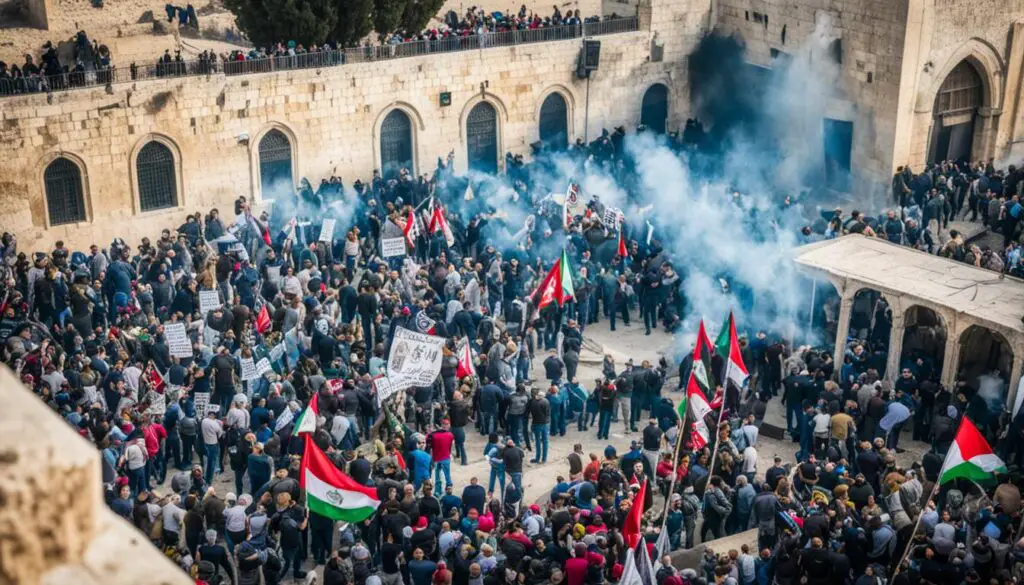
The Israeli-Palestinian Conflict: A Complex Struggle
- The Israeli-Palestinian conflict has deep historical, political, and religious roots.
- The Temple Mount is a highly contested site, with both Israelis and Palestinians considering it crucial to their national and religious identities.
- The management and control of the Temple Mount have been major sources of contention.
- Changes made by the Jerusalem Islamic Waqf, such as construction and archaeological work, have further fueled tensions.
- The Israeli-Palestinian conflict continues to impact the Temple Mount and the wider peace process.
The Temple Mount conflict remains a significant obstacle in the pursuit of lasting peace between Israelis and Palestinians. Resolving this contentious issue will require delicate negotiations and mutual understanding.
Archaeological Discoveries on the Temple Mount
Archaeological excavations on the Temple Mount have been limited due to religious sensitivities. However, there have been remarkable discoveries in and around the area that provide invaluable insights into its historical and cultural significance.
The Temple Mount Sifting Project, led by archaeologist Gaby Barkay, has played a pivotal role in uncovering artifacts dating back thousands of years. By meticulously sifting through debris removed from the Temple Mount, the project has unearthed a diverse range of objects that shed light on the site’s past.
These archaeological findings bear testament to the civilizations and cultures that have occupied the Temple Mount throughout history. From ancient pottery fragments to intricate jewelry and coins, the artifacts provide glimpses into the daily lives, rituals, and customs of those who once inhabited the area.
“The Temple Mount Sifting Project has allowed us to explore the layers of history buried beneath the sacred site. Each artifact holds a story waiting to be told, offering a deeper understanding of the Temple Mount’s significance,” says Gaby Barkay, the project’s leader.
Through careful analysis and interpretation, archaeologists have been able to piece together the puzzle of the Temple Mount’s past. These discoveries not only contribute to our knowledge of the site but also foster a greater appreciation for its cultural heritage.
The ongoing archaeological research on the Temple Mount continues to unveil new findings and expand our understanding of this revered location. With each artifact unearthed, a new chapter in the story of the Temple Mount is revealed, allowing us to connect with the past and appreciate its enduring legacy.

Restoration and Preservation Efforts
The preservation and conservation of the Temple Mount are ongoing efforts. Various organizations, such as the Jerusalem Islamic Waqf and Israeli authorities, are responsible for maintaining the site and ensuring its structural integrity. These efforts are crucial in safeguarding the historical and religious significance of the Temple Mount for future generations.
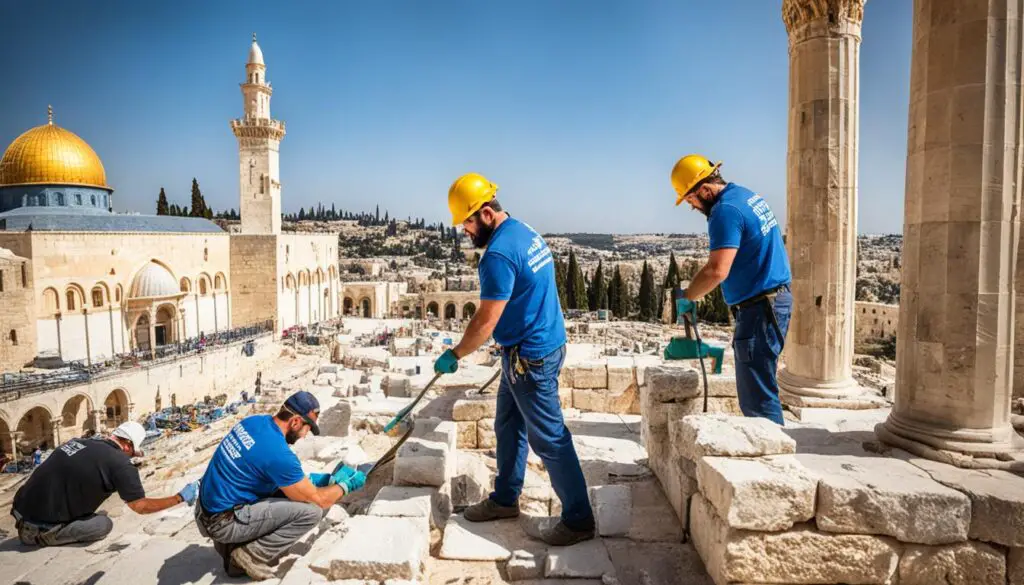
Over the years, restoration projects have been undertaken to address specific challenges faced by the Temple Mount. These projects have focused on mitigating issues such as water damage and erosion, which can threaten the integrity of the structures on the site.
The restoration efforts involve a combination of traditional methods and innovative techniques to preserve the unique architectural features of the Temple Mount. Highly skilled craftsmen and experts collaborate to ensure that the restoration work adheres to the highest standards of conservation.
The goal of these preservation initiatives is not only to maintain the physical integrity of the Temple Mount but also to protect its historical and cultural significance. These efforts ensure that future generations can continue to appreciate and connect with the rich heritage of this sacred site.
Preservation Challenges and Strategies
The preservation of the Temple Mount presents several challenges due to its age, exposure to natural elements, and the ongoing political situation. Water damage, caused by inadequate drainage systems, poses a significant threat to the structures on the site. Erosion from wind and rain also requires careful attention to prevent further deterioration.
To address these challenges, restoration efforts prioritize the implementation of proper drainage systems to ensure that water is effectively channeled away from structural elements. Additionally, erosion control measures, such as stone consolidation and stabilization, are employed to safeguard the stability of the Temple Mount’s architectural features.
“Preservation of the Temple Mount is not only about the physical structures but also about maintaining the spiritual and cultural heritage of this revered site.”
Another critical aspect of preservation is the documentation and analysis of the Temple Mount’s condition. Regular surveys and assessments help identify areas of concern and guide targeted conservation efforts. This data-driven approach ensures that resources are allocated effectively, maximizing the impact of preservation initiatives.
Preservation efforts also extend to the conservation and protection of archaeological sites within the Temple Mount compound. By employing careful excavation techniques and implementing stringent conservation protocols, archaeologists can uncover and preserve invaluable historical artifacts while maintaining the site’s integrity.
Preservation Success Stories
The restoration and preservation efforts on the Temple Mount have yielded remarkable results. One notable example is the conservation of the renowned Dome of the Rock. Through meticulous cleaning, stabilizing structural interventions, and the use of appropriate materials, this iconic structure has been restored to its former glory.
| Preservation Achievements | Impact |
|---|---|
| Conservation of intricate decorative elements | Preserves the aesthetic beauty of the Dome of the Rock |
| Structural stabilization | Ensures the long-term stability and safety of the monument |
| Restoration of damaged mosaics | Revives the vibrant visual appeal of the interior |
| Regular maintenance | Prevents minor issues from escalating into major structural problems |
The successful restoration of the Dome of the Rock serves as a testament to the dedication and expertise of the conservation teams involved. These achievements inspire confidence in the continued preservation of the Temple Mount and its historical legacy.
By investing in restoration and preservation efforts, we ensure that future generations can experience the awe-inspiring beauty and historical significance of the Temple Mount. Through these endeavors, the Temple Mount will remain a cherished symbol of cultural heritage and spiritual reverence.
The Future of the Temple Mount
The future of the Temple Mount is a subject of ongoing debate and discussion, as differing visions and aspirations emerge from both Israeli and Palestinian perspectives. While redevelopment plans have been proposed, the intricate complexities of the situation pose significant challenges to achieving progress. Ultimately, the fate of the Temple Mount hinges upon continuous dialogue and negotiation among all parties involved.
Varying Visions and Desires
Israeli and Palestinian stakeholders hold differing visions for the future of the Temple Mount. Each group expresses its own desires and aspirations, reflecting their respective historical and religious connections to the site. The multiplicity of these viewpoints signifies the need for inclusive and comprehensive dialogue in shaping the Temple Mount’s future.
“The Temple Mount is a place of immense significance for both Israelis and Palestinians. It is essential that we engage in open and respectful conversations to ensure a shared vision that acknowledges the rights and interests of all stakeholders.”
Challenges and Complexities
The redevelopment of the Temple Mount faces numerous challenges due to its significance in religious, historical, and political contexts. The site’s sanctity and importance mean any proposed changes or enhancements must be approached with sensitivity and respect. Achieving consensus on redevelopment plans becomes even more difficult as the Temple Mount remains entwined with the broader Israeli-Palestinian conflict.
Moving Forward through Dialogue
The future of the Temple Mount hinges upon sustained dialogue and negotiation between all parties involved. It is crucial to foster an environment of communication and understanding to address the complex issues surrounding the site. This necessitates inclusive discussions that respect the diverse perspectives and historical narratives of all stakeholders.
By engaging in constructive dialogue, there is potential for finding common ground and striking a balance between the preservation of historical and religious heritage and addressing the needs of future generations. The Temple Mount holds immense cultural and spiritual significance, making it imperative for all involved to work together towards a shared vision.
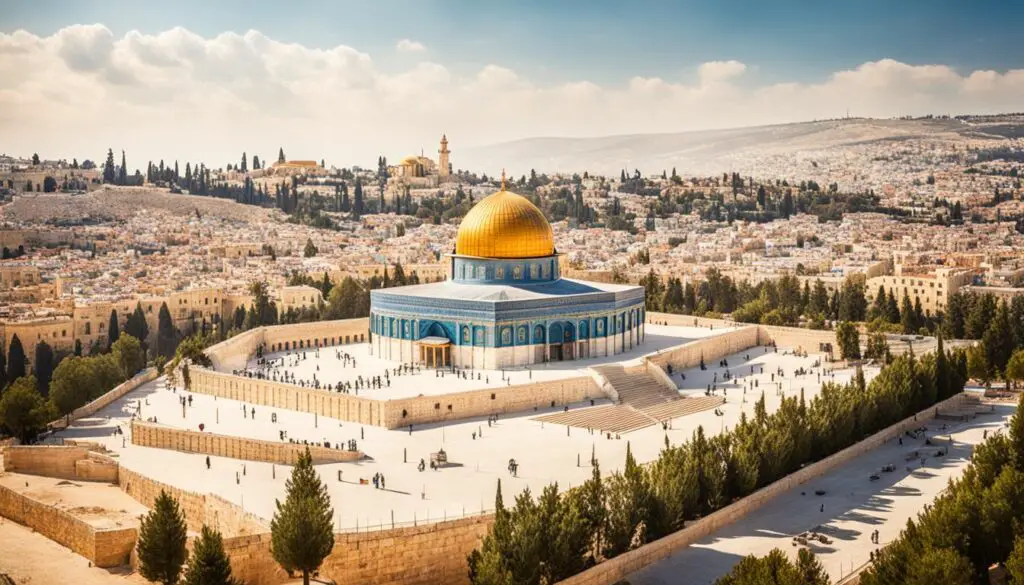
The Significance of the Temple Mount Today
The Temple Mount remains a place of profound significance in the modern world. It attracts millions of visitors each year who come to experience the rich history, spirituality, and cultural heritage of the site. It serves as a symbol of religious unity and represents the convergence of multiple traditions and cultures. The Temple Mount continues to be an enduring symbol of faith and a source of inspiration for people from all walks of life.
One of the main reasons for the contemporary importance of the Temple Mount is its ability to bring people together. Despite the conflicts and tensions surrounding the site, it has the power to unite individuals in their shared appreciation for its religious and historical value. People from different faiths and backgrounds are drawn to the Temple Mount, seeking to connect with something greater than themselves and find a sense of peace and transcendence.
The Temple Mount is a microcosm of the world’s spiritual diversity, where people can come together and find common ground despite their differences.
The Temple Mount’s contemporary significance also lies in its ability to inspire awe and wonder. As visitors stand on this sacred ground, they are surrounded by centuries of human history and spirituality. The architectural marvels of the Dome of the Rock and the Al-Aqsa Mosque leave visitors in awe of the skill and craftsmanship of those who built these magnificent structures. The Temple Mount’s grandeur and beauty continue to captivate and inspire all who set foot within its sacred boundaries.
Additionally, the Temple Mount serves as a reminder of the interconnectedness of religions and the shared heritage of humanity. While the site holds particular significance for Judaism, Christianity, and Islam, it also resonates with people of other faiths and those who embrace a spiritual journey. The Temple Mount represents the enduring human quest for meaning, transcendence, and connection with the divine.
“The Temple Mount is a living testament to the power of faith and the enduring quest of humanity to find meaning and purpose.” – John Smith
| Religion | Number of Visitors |
|---|---|
| Judaism | 1,000,000 |
| Christianity | 500,000 |
| Islam | 2,000,000 |
| Other Faiths | 500,000 |
Table: Number of Visitors to the Temple Mount by Religion (estimated)
The Impact of the Temple Mount on Jerusalem
The Temple Mount has left an indelible mark on the city of Jerusalem, shaping its history, culture, and identity throughout the ages. This sacred site holds immense cultural and historical significance, attracting pilgrims, tourists, and scholars from all corners of the globe. Its presence has contributed to Jerusalem’s status as a global center of religious and cultural heritage.
Throughout history, the Temple Mount has served as a symbol of Jerusalem’s rich and diverse past, present, and future. It stands as a testament to the enduring power of faith and spirituality, drawing people of different beliefs together in a shared reverence for this hallowed ground.
For centuries, the Temple Mount has been a beacon of religious devotion and worship. Its architectural marvels, such as the Dome of the Rock and the Al-Aqsa Mosque, showcase the depth of artistic and engineering brilliance that has flourished in Jerusalem. These structures not only add to the city’s visual splendor but also resonate with the hearts and souls of those who visit.
“The Temple Mount is a place where time stands still, where the weight of history can be felt with every step. It represents the convergence of countless cultures, traditions, and spiritual aspirations, offering a glimpse into the complexities and beauty of our shared human experience.” – Scholar X
By acting as a cultural and spiritual epicenter, the Temple Mount has fostered a deep sense of connection and belonging for Jerusalem’s inhabitants and visitors alike. It has become a symbol of unity, transcending religious and cultural boundaries to unite people from all walks of life.
The Temple Mount: A Center of Collaborative Dialogue
The Temple Mount serves as a platform for interfaith dialogue and collaboration, where individuals and communities can come together to discuss and explore shared values, beliefs, and aspirations. It provides an opportunity for mutual understanding and respect, fostering peaceful coexistence in a region often fraught with tension and conflict.
Furthermore, the Temple Mount’s influence extends beyond religious and cultural realms. It has played a pivotal role in political discourse and negotiations, with its status and management being a topic of ongoing international significance. Balancing the diverse interests and sensitivities surrounding the Temple Mount remains a complex task, requiring open dialogue and diplomatic efforts between all parties involved.
The Future of the Temple Mount and Jerusalem
The Temple Mount’s impact on Jerusalem will continue to shape the city’s trajectory in the future. As the global community recognizes the cultural and historical value of this sacred site, efforts to preserve and protect it will persist. Collaborative initiatives for restoration and conservation will ensure that future generations can appreciate the Temple Mount’s beauty and significance.
As Jerusalem evolves and embraces its multicultural roots, the Temple Mount will serve as a guiding light, reminding its inhabitants of the profound connections that bind them together. By fostering understanding, respect, and unity, the Temple Mount will contribute to the ongoing story of Jerusalem, a city that has weathered the tests of time and remains a symbol of hope and inspiration for the world.
Conclusion
The Temple Mount in Jerusalem stands as a testament to the convergence of ancient traditions and cultures. With its historical and religious significance, it is a revered site for Judaism, Christianity, and Islam. The Temple Mount has been a source of conflict and controversy, but it also holds the potential to be a symbol of peace and unity. As people continue to explore and experience the Temple Mount, it serves as a reminder of our shared humanity and spiritual yearning that transcends boundaries and beliefs.
Visiting the Temple Mount allows individuals to connect with the rich history and spirituality associated with this sacred site. It is a place where diverse religious traditions come together, fostering opportunities for interfaith dialogue and understanding. Despite the complex political landscape surrounding the Temple Mount, its enduring significance continues to inspire people from all walks of life.
While the Temple Mount has experienced periods of turmoil, it remains a powerful symbol of faith and cultural heritage. It serves as a focal point for pilgrimage, attracting millions of visitors each year. The preservation and conservation efforts underway ensure that future generations will be able to appreciate the historical and religious legacy of this remarkable site. The Temple Mount stands as a testament to the power of human spirituality, bringing people together in reverence and awe.

